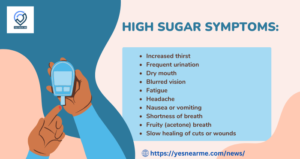Symptoms of Diabetes
When blood glucose (sugar) levels are too high, it can lead to diabetes. The body uses glucose as its primary energy source, and although glucose can be produced by the body, in people with this condition, the body either doesn’t produce enough insulin or doesn’t use it properly. The symptoms associated with high blood sugar can increase the risk of damage to kidneys, nerves, eyes, and the heart. Several types of cancers have also been linked to the condition. By taking preventive steps, you can lower your risk of health problems.
Type 1 Symptoms tend to develop rapidly within weeks, while Type 2 symptoms often appear gradually over the course of years, sometimes with such mild signs that they go unnoticed.
-
Frequent urination: This occurs because the body tries to flush out excess glucose through urine. The kidneys can’t absorb all the glucose when blood sugar levels are high, leading to more urine production.
-
Excessive thirst: Known as polydipsia, this is a classic symptom. The body loses fluids through frequent urination, which causes dehydration and leads to increased thirst.
-
Extreme Hunger: When glucose isn’t able to enter cells, the body lacks energy, which triggers intense hunger, leading to overeating.
-
Fatigue: High blood sugar leads to energy loss through urination, leaving the body feeling tired.
-
Blurred vision: High glucose levels cause fluid imbalances, which may result in swelling in the eye, leading to difficulty focusing and blurry vision.
-
Slow healing wounds or cuts: Elevated blood sugar can damage blood vessels and nerves, making the healing process of cuts and wounds slower.
-
Tingling or numbness in hands or feet: Prolonged high blood sugar can lead to nerve damage, which may cause a tingling sensation or numbness in the extremities.
-
Dry mouth and itchy skin: Dehydration caused by high glucose can lead to dry mouth and itchy skin.
-
Unexpected weight loss: When the body is deprived of glucose, it starts breaking down fat and muscle for energy, resulting in significant weight loss.
-
Increased irritability or moodiness: Fluctuations in blood sugar can lead to mood changes, causing irritability or emotional disturbances.
Normal Blood Sugar Levels
Blood sugar levels vary from person to person and at different times of the day. However, the American Diabetes Association (ADA) recommends the following blood sugar level ranges for most healthy adults:
- Fasting blood sugar (before eating): 70 to 130 mg/dL (3.9 to 7.2 mmol/L).
- Blood sugar 2 hours after eating: Less than 180 mg/dL (10.0 mmol/L).
It’s essential for individuals to monitor their blood glucose regularly and consult a healthcare professional for specific guidance.
Types of Diabetes:

There are three main types of diabetes:
- Type 1 diabetes: This is an autoimmune disease in which the immune system attacks and destroys insulin-producing cells in the pancreas. People with type 1 diabetes are unable to produce insulin and are dependent on insulin injections or an insulin pump to regulate their blood sugar levels.
- Type 2 diabetes: This is the most common type of diabetes, accounting for about 90% of all cases. The body develops a resistance to the effects of insulin in type 2 diabetes, and the pancreas may not generate enough insulin to overcome the resistance. Type 2 diabetes can often be managed with lifestyle changes, such as exercise, diet, and medication.
- Gestational diabetes: This type of diabetes occurs during pregnancy, usually in the second or third trimester. Hormonal changes that reduce the body’s sensitivity to insulin are the cause of it. Gestational diabetes usually goes away after delivery, but women who develop it are at increased risk of developing type 2 diabetes later in life.
Less common types of diabetes include:
– LADA (Latent Autoimmune Diabetes in Adults)
– MODY(Diabetes in Young People With Maturity-Onset)
– Secondary diabetes (caused by other conditions such as cystic fibrosis or pancreatitis)
Low sugar symptoms :

Low blood sugar, also called hypoglycemia, occurs when the level of glucose (sugar) in the blood drops below normal. The symptoms of low blood sugar can vary depending on the severity of the condition, but common symptoms include:
- Shakiness
- Sweating
- Dizziness or lightheadedness
- Confusion or difficulty concentrating
- Anxiety or irritability
- Hunger or nausea
- Headache
- Blurred vision
- Rapid heartbeat/palpitations
In severe cases, low blood sugar can cause loss of consciousness, seizures, and coma. It is important to recognize the symptoms of low blood sugar and treat it promptly by consuming a source of glucose such as juice, candy, or glucose tablets. If you experience recurrent episodes of low blood sugar or have difficulty managing your blood sugar levels, consult a healthcare professional for personalized advice.
High sugar symptoms:

High blood sugar, also called hyperglycemia, is a condition where the level of glucose (sugar) in the blood is higher than normal. Symptoms of high blood sugar can vary depending on the severity of the condition, but common symptoms include:
- Increased thirst
- Frequent urination
- Dry mouth
- Blurred vision
- Fatigue
- Headache
- Nausea or vomiting
- Shortness of breath
- Fruity (acetone) breath
- Slow healing of cuts or wounds
If left untreated, high blood sugar can lead to diabetic ketoacidosis (DKA), a life-threatening complication. It is important to manage high blood sugar levels by following a healthy diet, exercising regularly, taking medications as prescribed, and monitoring blood sugar levels as recommended by a healthcare professional. If you experience symptoms of high blood sugar, consult a healthcare professional for personalized advice on how to manage your condition.
Diabetes Treatment:

Diabetes treatment focuses on managing blood sugar levels to prevent complications. The treatment plan for diabetes varies depending on the type of diabetes and individual needs, but the following are common approaches:
- Healthy Diet: A balanced and healthy diet that includes complex carbohydrates, lean protein, healthy fats, and fiber can help regulate blood sugar levels. It’s also crucial to stay away from processed and sugary foods.
- Regular Exercise: Exercise can help reduce blood sugar levels and improve insulin sensitivity. Five days a week, try to get in at least 30 minutes of moderate-intensity exercise.
- Medications: Depending on the type of diabetes, medications such as insulin, metformin, and oral antidiabetic drugs may be prescribed to regulate blood sugar levels.
- Monitoring: Regular monitoring of blood sugar levels is important to make adjustments to the treatment plan as necessary.
- Managing Complications: Treatment may also involve managing complications such as high blood pressure, high cholesterol, and neuropathy.
- Education and Support: Education about diabetes and access to support can help individuals better manage their condition and prevent complications.
Conclusion :
It is important to work closely with a healthcare professional to develop an individualized treatment plan that meets your needs. Lifestyle changes play a crucial role in the management of diabetes, so it is important to make healthy lifestyle choices and follow up with regular appointments. If you want International Tea Day quotes check out.
visit yesnearme Instagram page: yesnearme_official







Recent Comments